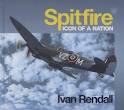Spitfire: Icon of a Nation
Spitfire: Icon of a Nation
By Ivan Rendall
While not a new release (first published in 2008) we felt that this book is more than worthy of our inaugural review.
Judging a book by its cover: the jacket photo and design (a Spitfire in fighting camouflage roaring skyward against a clouded and graduated blue background) leaves no doubt as to what this book is all about. First impressions are good. A quick thumb through the book reveals most pages have at least one photo of either the aircraft or those responsible for designing, building or flying it. The photos are clear, well placed on the page and diverse in nature. Rendall has also achieved an excellent contrast between archival and contempary shots. Second impressions are even better!
The contents page lists the chapters as follows: Speed, Air Power, Science and Art, War, Battle, Fighting Machine, Flying Legend, Star and Celebrity, Selected Marks and Bibliography. While this may not indicate the chronology of Spitfire development and later events at first glance, that however is the case. The Introduction is excellent and is resplendent with a very formal photo of Reginald J. Mitchell (taken in 1932 at his award ceremony for the CBE: Commander of the British Empire). This excerpt from page 1 is bound to elicit emotion from any aviator: “The Spitfire is the ultimate paradox. Flying low and fast, the effortless urgency of its Merlin engine announcing its arrival, it stirs contradictory emotions: awe at its sheer elegance in flight, and a troubling admiration for its obvious and deadly purpose – to destroy and to kill.” There are references to the Battle of Britain, to the producers of probably the most famous engine in the world (the Rolls Royce Merlin) and to the little known fact that German aircraft blasted from the skies over England actually contributed valuable metal to the construction of the Spitfire!
Chapter 1 looks at the early days of aviation, focuses on Mitchell’s upbringing, education and path towards becoming an aircraft designer, and discusses at length how the races for the Schneider Trophy were critical to the development of increasingly faster British aircraft, from the humble 150mph Supermarine Sea Lion MkII through to the 407mph S6B.
From here on the chronology becomes very evident as the next chapter deals with the British Air Ministry and its RAF tender for a new fighter. The following pages look closely at how and why Mitchell was awarded the contract, his radical decision to create RAF Specification F7/30 as a monoplane (as opposed to a biplane), and how the need for speed and fighting ability slowly morphed the Type 224 into the now universally recognisable shape of the prototype Spitfire (No K5054).
The 1930’s were a time of great change: the Great Depression, the rise of Adolph Hitler and his Nazi party, huge leaps forward in technology and science. For Supermarine (and the world in general) a great loss came to pass: RJ Mitchell died on 11 June 1937. Chapter 3 looks at this decade and how the Spitfire rose to become the choice of the RAF and the beloved mount of the British fighter pilots.
The Battle of Britain. Four words that evoke very strong emotion: sadness, fear, anger, pride – spine tingling pride. And an indelible image: Spitfire! Hitler had offered Britain a chance to surrender but Churchill made it absolutely clear that the British would stand their ground come what may. And they came – and they got blasted from the sky. The skies over England twisted and turned with the writhing contrails of Spitfires and Messerschmitts during the summer of 1940. And the Nazi aviators (including Galland) learned quickly that air superiority had a new name – Spitfire. I particular like Chapter 5 for its intimate look at some of the significant air battles (within the Battle of Britain) and at some of the outstanding pilots that flew the Spitfire – Alan Deere, Douglas Bader, Brian Lane to name a few.
I think I’ve rattled on enough. This book is an outstanding testimony to the Spitfire and those who produced and flew her. My only criticism is to do with the size of the book. Whilst easy to manhandle whilst reclining in your Lazyboy with a beer or Glenfiddich (or both!) it’s readily lost on the book shelf and looks a little out of place on the coffee table. This is only a small criticism and one that is far outweighed by the positive aspects of this publication. Enjoy!